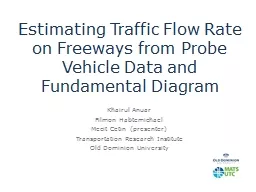

Diagram Khairul Anuar PhD Candidate Dr Filmon Habtemichael Dr Mecit Cetin presenter Transportation Research Institute Old Dominion University Introduction Point sensors Aggregate data Flow speed occupancy ID: 780596
Download The PPT/PDF document "Estimating Traffic Flow Rate on Freeways..." is the property of its rightful owner. Permission is granted to download and print the materials on this web site for personal, non-commercial use only, and to display it on your personal computer provided you do not modify the materials and that you retain all copyright notices contained in the materials. By downloading content from our website, you accept the terms of this agreement.
Slide1
Estimating Traffic Flow Rate on Freeways from Probe Vehicle Data and Fundamental Diagram
Khairul Anuar (PhD Candidate)Dr. Filmon HabtemichaelDr. Mecit Cetin (presenter)Transportation Research InstituteOld Dominion University
Slide2Slide3Introduction
Point sensorsAggregate data: Flow, speed, occupancy Relatively high cost Probe data
Individual vehicle trajectories (but data providers aggregate)
Sample size might be small Relatively low cost
Goal: Estimate traffic flow
rate from
raw
probe
data
Slide4Literature Review
Flow estimationEstimation of flow and density using probe vehicles with spacing measurement equipment (Seo et al, 2015)Deriving traffic volumes from PV data using a fundamental diagram approach (Neumann et al, 2013)
Traffic states (queue length, travel time)Real time traffic states estimation on arterial based on trajectory data (
Hiribarren and Herrera, 2014)
Slide5Objectives
Estimate traffic flow on freeways from PV data and fundamental diagramUnique from previous studies
Four different FDs Aggregation intervals of 5, 10 and 15 minutes
Slide6Methodology
From FD estimate flow
q when speed u
is knownu is probe vehicle speed
Slide7Methodology
Four different models of fundamental diagram
Model
Speed-Density Relationship
Regression
Greenshield
Underwood
Northwestern
Van
Aerde
,
,
,
Model
Speed-Density Relationship
Regression
Greenshield
Underwood
Northwestern
Van
Aerde
Slide8Methodology
Performance indicators
F
i
is the
i
th
estimate value
O
i
is the
i
th
observe value
n
is the number of samples
Slide9Mobile Century (I-880 SF Bay area)
Case Study
Probe vehicle trajectory
Study site
NB
S
B
Length: 12 mile
Due to known recurring congestion, NB is analyzed
Slide10Field DataProbeCollected by 165 drivers on Friday Feb 8, 2008
2-5% of total trafficGPS points @ 3-sec on averageLoopSpeed-flow data aggregated by 5-minute intervals for about one month
Slide11Speeds
Slide12Case Study
Loop vs PV speed
Fundamental diagram
Slide13Results
Comparison of loop detector and estimated flow from fundamental diagram
Slide14Results
Distribution of percentage error for different FDs and aggregation intervals
FD models
Aggregation interval
MAPE
(abs %)
RMSE
(vphpl)
Avg. Error
Std. Dev.
Greenshield
5-min
12.5
189
-2.1
17.1
10-min
11.1
169-2.215.215-min11.1168-2.214.7Underwood5-min11.7178-8.914.610-min11.3174-9.013.515-min10.9167-9.012.9Northwestern5-min8.7130-5.410.410-min
7.1
107
-5.5
8.2
15-min
6.8
103
-5.5
7.7
Van
Aerde
5-min
6.4
98
-2.9
8.1
10-min
5.3
83
-3.0
6.2
15-min
5.2
79
-3.0
6.2
Slide15Conclusions
Van Aerde provides the best resultHigher accuracies as aggregation interval increasesEstimates are more accurate during congestion rather than free-flow
Slide16Future WorkFocus on congestion period
Utilize shockwave theory to identify additional traffic stateOther sites
Slide17Questions?Funded by Mid-Atlantic Transportation Sustainability Center – Region 3 University Transportation Center